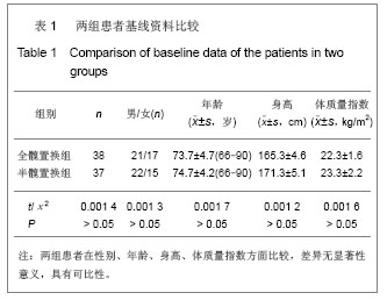| [1]Suckel AA,Dietz K,Wuelker N,et al.Evaluation of complications of three different types of proximal extra-articular femur fractures Differences in complications, age, sex and surviving rates. Int Orthop.2007;31(5): 689-695.[2]Harris WH.Traumatic of the hip after dislocation and acetabular fracture; Treatmeant by mold arthroplasty. J Bone Joint Surg.1969;51A:737-755.[3]Mahoney FI , Bart helD. Funct i on alevaluation: the Barthel Index. Md Med J.1956;14:56-61 .[4]Zhang N, Li SQ, Li DS, et al. Zhongguo Jiaoxing Waike Zazhi. 2011;19(4):268-271.张宁,李叔强,李冬松,等.全髋关节置换术与人工双极股骨头置换术治疗老年新鲜移位股骨颈骨折的近期疗效比较[J].中国矫形外科杂志,2011,19(4):268-271.[5]Verbeek DOF, Ponsen KJ, Goslings JC, et al. Effect of surgical delay on outcome in hip fracture patients: a retrospective multivariate analysis of 192 patients. Int Orthop. 2008;32(1): 13-18.[6]Leonardsson O, Sernbo I, Carlsson A, et al. Long-termfollow-up of replacement compared with internal fixation fordisplaced femoral neck fractures: results at ten years in a randomised study of 450 patients. J Bone Joint Surg Br.2010;92(3):406-412.[7]Illgen R, Rubash HE. The optimal fixation of the cementless acetabular component in primary total hip arthroplasty. J Am Acad Orthop Surg2002;10(1):43-56.[8]Gjertsen JE, Vinje T, Engeseter LB, et al. Internal screw fixation compared with bipolar hemi-arthroplasty for treatment of displaced femoral neck fractures in elderly patients. J Bone Joint Surg Am,2010,92:619-628.[9]Tzanetis AS, Dimitrios NL, Ioannis GP, et al. Fracture of the femoral neck treated with hemi-arthoplasty. A comparative study[J]. Folia Medica,2009,51:34-39.[10]Parker MJ, White A, Boyle A. Fixation versus hemiarthroplasty for undisplaced intracapsular hip fractures. Injury.2008;39(7):791-795.[11]Keating J, GrantA, Masson M, et al. Randomized comparision of reduction and fixation, bipolar hemi-arthroplasty, and total hip arthroplasty. Treatment of displaced intracapsular hip fractures in healthy older patients. J Bone Joint Surg Am.2006; 88:249-260.[12]Goh SK, Samuel M, Su DH, et al. Meta analysis comparing total hip arthroplasty with hemi-arthroplasty in the treatment of displaced neck of femur fracture. J Arthroplasty.2009;3: 400-406.[13]Martin JH, Cecilia R, Frede F, et al. Internal fixation versus arthroplasty for displaced femoral neck fractures: what is the evidence. J Orthop Trauma.2009;23:395-402.[14]Macauly W, Nellans KW, Iorio R, et al. Total hip arthroplasty is less painful at 12 months compared with hemiarthroplasty in treatment of displaced femoral neck fracture.2008;1:48-54.[15]Iorio R, Schwartz B, Macaulay W, et al. Surgical treatment of displaced femoral neck fractures in the elderly: a survey of the American Association of Hip and Knee Surgeons. J Arthroplasty. 2006;21:1124.[16]Baker R, Squires B, Gargan MF, et al. Total hip arthroplasty and hemiarthroplasty in mobile, independent patients with a displaced intracapsular fracture of the femoral neck. J Bone Joint Surg Am.2006;88A:2583. |

